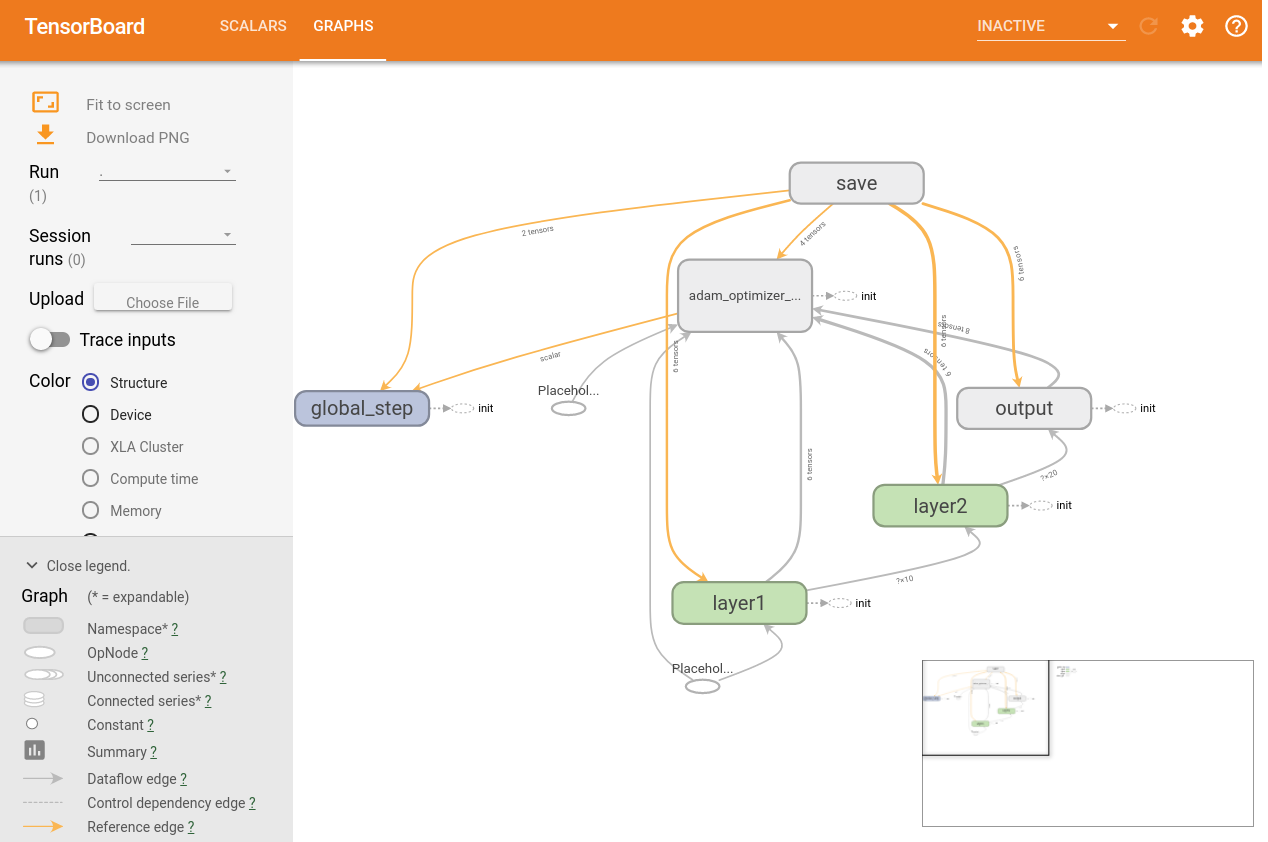005-002. how to configure vairables to use tensorboard
import tensorflow as tf
import numpy as np
loaded_data_csv=np.loadtxt(\
'/home/young/문서/data.csv'\
,delimiter=','\
,unpack=True\
,dtype='float32')
x_data=np.transpose(loaded_data_csv[0:2])
y_data=np.transpose(loaded_data_csv[2:])
# @
# You will build model
global_step=tf.Variable(0,trainable=False,name='global_step')
X_placeholder_node=tf.placeholder(tf.float32)
Y_placeholder_node=tf.placeholder(tf.float32)
# Block which is grouped by "with tf.name_scope('layer1'):" will show,
# in one layer in tensorboard
with tf.name_scope('layer1'):
W_variable_in_layer1_node\
=tf.Variable(tf.random_uniform([2,10],-1.,1.),name='W_variable_in_layer1_node')
hypothesis_f_in_layer1_node\
=tf.nn.relu(tf.matmul(X_placeholder_node,W_variable_in_layer1_node))
with tf.name_scope('layer2'):
W_variable_in_layer2_node\
=tf.Variable(tf.random_uniform([10,20],-1.,1.),name='W_variable_in_layer2_node')
hypothesis_f_in_layer2_node\
=tf.nn.relu(tf.matmul(hypothesis_f_in_layer1_node,W_variable_in_layer2_node))
with tf.name_scope('output'):
W_variable_in_layer3_node\
=tf.Variable(tf.random_uniform([20,3],-1.,1.),name='W_variable_in_layer3_node')
hypothesis_function_node=tf.matmul(hypothesis_f_in_layer2_node,W_variable_in_layer3_node)
with tf.name_scope('adam_optimizer_node'):
cost_function_node=tf.reduce_mean(tf.nn.softmax_cross_entropy_with_logits(\
labels=Y_placeholder_node\
,logits=hypothesis_function_node))
adam_optimizer_node=tf.train.AdamOptimizer(learning_rate=0.01)
to_be_trained_node=adam_optimizer_node.minimize(cost_function_node,global_step=global_step)
# You can specify values which you want tensorboard to collect,
# by tf.summary.scalar()
tf.summary.scalar('cost_function_node',cost_function_node)
# @
# You will train model
sess_object=tf.Session()
saver_object=tf.train.Saver(tf.global_variables())
ckeckpoint_directory=tf.train.get_checkpoint_state('/home/young/문서/model')
if ckeckpoint_directory and tf.train.checkpoint_exists(ckeckpoint_directory):
saver_object.restore(sess_object,ckeckpoint_directory)
else:
sess_object.run(tf.global_variables_initializer())
# You merge tennsors which you want to show on tensorboard
merged_tensor_node=tf.summary.merge_all()
# You designate directory where graph and tensors will be saved
writer_node=tf.summary.FileWriter('/home/young/문서/logs',sess_object.graph)
# You can use "log" file like following steps
# 1. You run webserver with following command
# tensorboard --logdir=/home/young/문서/logs
# 1. You go to http://localhost:6006
# @
# You will perform train
for step in range(100):
sess_object.run(\
to_be_trained_node\
,feed_dict={X_placeholder_node:x_data,Y_placeholder_node:y_data})
print('Step: %d,' % sess_object.run(global_step),
'Cost: %.3f' % sess_object.run(\
cost_function_node\
,feed_dict={X_placeholder_node:x_data,Y_placeholder_node:y_data}))
# You should collect and save vairables at proper time
summary_of_tensor=sess_object.run(\
merged_tensor_node\
,feed_dict={X_placeholder_node:x_data,Y_placeholder_node:y_data})
writer_node.add_summary(\
summary_of_tensor\
,global_step=sess_object.run(global_step))
saver_object.save(sess_object,'/home/young/문서/model/dnn.ckeckpoint_directory',global_step=global_step)
# @
# You will see result
prediction_after_argmax_node=tf.argmax(hypothesis_function_node,1)
label_after_argmax_node=tf.argmax(Y_placeholder_node,1)
print('Prediction value:',sess_object.run(prediction_after_argmax_node,feed_dict={X_placeholder_node: x_data}))
print('Label value:',sess_object.run(label_after_argmax_node,feed_dict={Y_placeholder_node: y_data}))
compare_prediction_and_label_node=tf.equal(prediction_after_argmax_node,label_after_argmax_node)
accuracy_node=tf.reduce_mean(tf.cast(compare_prediction_and_label_node,tf.float32))
print('Accuracy: %.2f' % sess_object.run(accuracy_node*100,feed_dict={X_placeholder_node:x_data,Y_placeholder_node: y_data}))
# img 557bd399-e3cc-477b-a127-f27753710b06
 # img 6f2465bd-2e16-4dff-a0ad-f0fb95171fe9
# img 6f2465bd-2e16-4dff-a0ad-f0fb95171fe9


